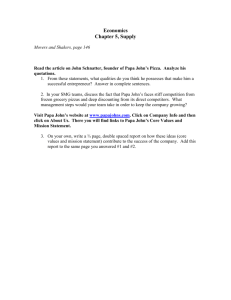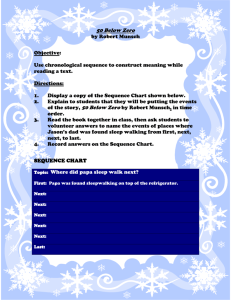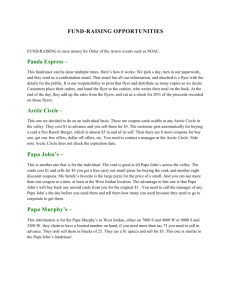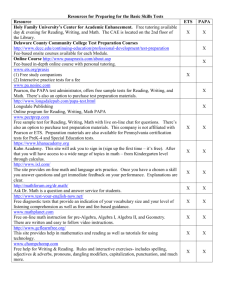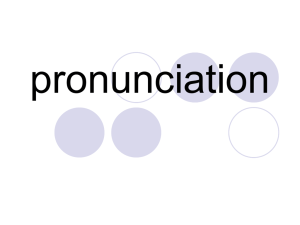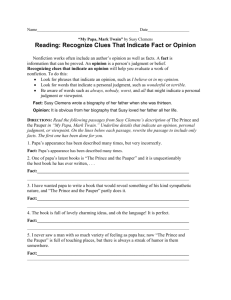TTUISD - TEKS Tracker
advertisement
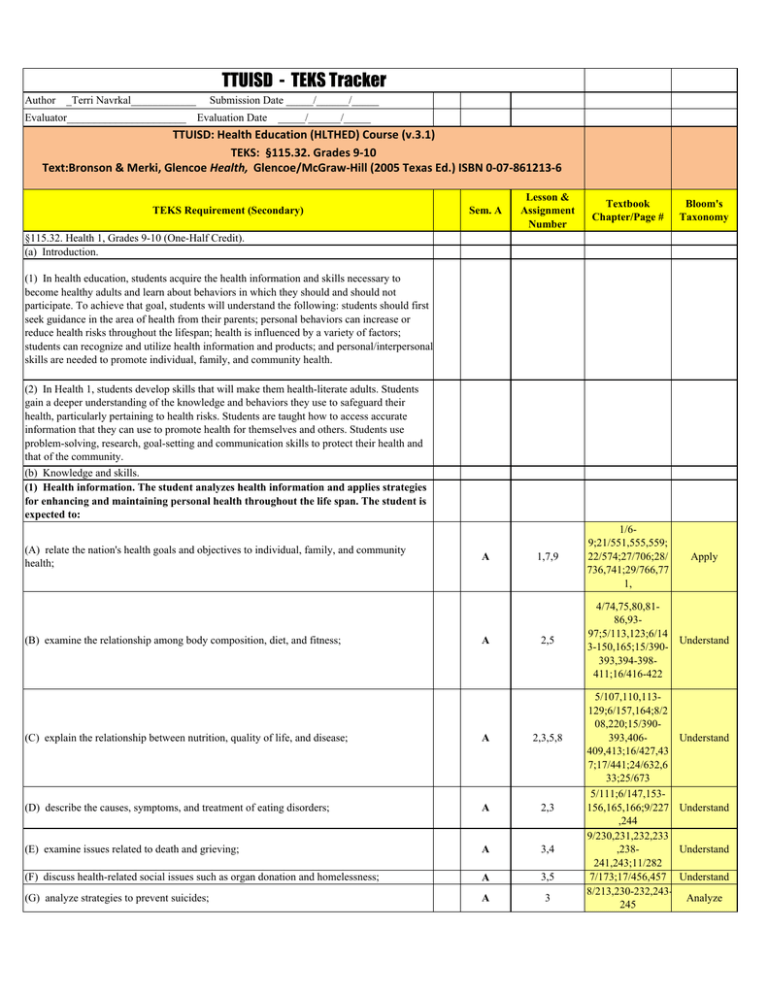
TTUISD - TEKS Tracker Author _Terri Navrkal____________ Evaluator______________________ Submission Date _____/______/_____ Evaluation Date _____/______/_____ TTUISD: Health Education (HLTHED) Course (v.3.1) TEKS: §115.32. Grades 9‐10 Text:Bronson & Merki, Glencoe Health, Glencoe/McGraw‐Hill (2005 Texas Ed.) ISBN 0‐07‐861213‐6 TEKS Requirement (Secondary) Sem. A Lesson & Assignment Number Textbook Chapter/Page # Bloom's Taxonomy 1,7,9 1/69;21/551,555,559; 22/574;27/706;28/ 736,741;29/766,77 1, Apply 2,5 4/74,75,80,8186,9397;5/113,123;6/14 3-150,165;15/390393,394-398411;16/416-422 Understand §115.32. Health 1, Grades 9-10 (One-Half Credit). (a) Introduction. (1) In health education, students acquire the health information and skills necessary to become healthy adults and learn about behaviors in which they should and should not participate. To achieve that goal, students will understand the following: students should first seek guidance in the area of health from their parents; personal behaviors can increase or reduce health risks throughout the lifespan; health is influenced by a variety of factors; students can recognize and utilize health information and products; and personal/interpersonal skills are needed to promote individual, family, and community health. (2) In Health 1, students develop skills that will make them health-literate adults. Students gain a deeper understanding of the knowledge and behaviors they use to safeguard their health, particularly pertaining to health risks. Students are taught how to access accurate information that they can use to promote health for themselves and others. Students use problem-solving, research, goal-setting and communication skills to protect their health and that of the community. (b) Knowledge and skills. (1) Health information. The student analyzes health information and applies strategies for enhancing and maintaining personal health throughout the life span. The student is expected to: (A) relate the nation's health goals and objectives to individual, family, and community health; (B) examine the relationship among body composition, diet, and fitness; A A (C) explain the relationship between nutrition, quality of life, and disease; A 2,3,5,8 (D) describe the causes, symptoms, and treatment of eating disorders; A 2,3 (E) examine issues related to death and grieving; A 3,4 (F) discuss health-related social issues such as organ donation and homelessness; A 3,5 (G) analyze strategies to prevent suicides; A 3 5/107,110,113129;6/157,164;8/2 08,220;15/390393,406409,413;16/427,43 7;17/441;24/632,6 33;25/673 5/111;6/147,153156,165,166;9/227 ,244 9/230,231,232,233 ,238241,243;11/282 7/173;17/456,457 8/213,230-232,243245 Understand Understand Understand Understand Analyze TEKS Requirement (Secondary) (H) examine causes and effects of stress and develop strategies for managing stress and coping with anxiety and depression; and (I) describe the importance of taking responsibility for establishing and implementing health maintenance for individuals and family members of all ages. Sem. A A A Lesson & Assignment Number Textbook Chapter/Page # Bloom's Taxonomy 1,2,3,4,5,6,7 2/31,32;4/75,78;6/ 150;7/177;8/197214,220,221;9/228 ,231234;11/280,282,28 5;16/436;17/449,4 59;19/497;23/612, 617; PAPA sessions 7,8,11 Analyze 1,2,3,5,6,8 1/5-7,1014,16,18;2/31,32;3 /59;4/7577,104,107;5/136, 137;7/171,177;8/2 02,204,208,213216;9/228234,236,237;14/36 0-366,367-370,371375,376379;19/504507;20/513;24/632 ,633;26/675,678680,682,683686,688,689,690,6 92-694,696,701 Apply 1,2,3,5,7,8 1/6,916;2/31;4/79,104,1 06,107;5/121,123, 129,136,137;6/146 ,147,166;7/177;9/2 25,226,227,229234,236;14/360366,367370;15/391,393,41 1;16/423,424,427, 435,436;17/452;18 /481;23/591;24/62 5,626,632,633,635641;25/648-651 Analyze (2) Health information. The student is health literate in disease prevention and health promotion throughout the life span. The student is expected to: (A) analyze the relationship between health promotion and disease prevention; A Lesson & Assignment Number Textbook Chapter/Page # Bloom's Taxonomy 1,2,3,5,7,8,9 1/6,916,23;2/31;5/104,1 06,107,123,129,13 6,137;6/146,147,1 66;7/177;9/225,22 6,227,229234,236;14/360366,367370;16/411,435,43 6;17/452;18/481;2 0/529,533;21/554, 555;23/591;24/625 ,626,632,633,635641;25/648651,657;26/699;29 /776 Analyze 1,3,4,5,6,7,8 2/43;3/54,59,64,65 ;8/213,215,216,21 9;9/223,228234,236,237,243,2 45;11/282,291295;16/437;21/550 ,557;22/578,579;2 3/612,613,615;24/ 633,643; PAPA sessions 8,13 Evaluate A 1,2,7,8,9 3/64,6;4/77,78;5/1 23,133,134137,139;23/611;24 /622,624626,632,633,635641;25/648651,659,661;26/67 5,677,679,680,682685,689,692-694 Analyze A 6 (B) explain the importance of the role of prenatal care and proper nutrition in promoting optimal health for both the baby and the mother such as breast feeding; A 2,6,8 (C) analyze the harmful effects of certain substances on the fetus such as alcohol, tobacco, other drugs, and environmental hazards such as lead; and A 6,7 (D) explain the significance of genetics and its role in fetal development. A 3,4 TEKS Requirement (Secondary) (B) analyze the influence of laws, policies, and practices on health-related issues including those related to disease prevention; (C) identify, describe, and assess available health-related services in the community that relate to disease prevention and health promotion; and (D) develop and analyze strategies related to the prevention of communicable and noncommunicable diseases. (3) Health information. The student recognizes the importance and significance of the reproductive process as it relates to the health of future generations. The student is expected to: (A) explain fetal development from conception through pregnancy and birth; (4) Health information. The student investigates and evaluates the impact of media and technology on individual, family, community, and world health. The student is expected to: Sem. A A A 19/486-491,511 Understand 6/162,163,166;19/ 485,487,492Understand 497;26/697; PAPA session 5 19/487,491,492,49 4,496,497;21/552, Analyze 555,557;22/575,57 6,579;23/619 9/293-293,306307;11/374;12/405 Understand ;13/423,444,460,4 61 TEKS Requirement (Secondary) (A) analyze the health messages delivered through media and technology; and (B) explain how technology has impacted the health status of individuals, families, communities, and the world. Sem. A A A Lesson & Assignment Number Textbook Chapter/Page # Bloom's Taxonomy 1,2,3,4,7,8,9 1/15,16;3/49,53,61 ,63,68,69;4/95;5/1 13,132,139;6/144, 151;9/233,235,243 ;12/317;13/343,34 7,437;23/594;24/6 40,641;26/665;27/ 725 Analyze 5,6,7 1/16;3/66;9/235,24 3;16/437;19/503;2 4/633,634,637641,644;26/664,66 Understand 5,667,695,701;27/ 727,729;28/761;29 /772-776,781 (5) Health information. The student understands how to evaluate health information for appropriateness. The student is expected to: (A) develop evaluation criteria for health information; A 1,2,3,8 (B) demonstrate ways to utilize criteria to evaluate health information for appropriateness; A 1,2,3,8 (C) discuss the legal implications regarding sexual activity as it relates to minor persons; and A 1,2,3,4,6,8 (D) demonstrate decision-making skills based on health information. (6) Health behaviors. The student assesses the relationship between body structure and function and personal health throughout the life span. The student is expected to: A 1,2,3,4,5,6 1/9,16,19;2/28,32; 3/48,50,51,53,61,6 3,69;5/130Evaluate 137;9/233,235,237 ;26/701,703 3/53,63,69;4/97;9/ 233,234,237,243;2 Evaluate 6/701,703 3/69;4/97;9/233,23 5,237,243;12/320, Understand 323;26/701,703; PAPA session 3 1/18,20;2/31,33,34 ,36,44;3/50,61;4/9 2,93,105;5/121,13 9;6/148,150,165;7/ 180,183;8/206;9/2 43;12/318320;14/366,381;15 Understand /389,398,407;16/4 37;17/452,459;19/ 506,509;20/519; PAPA sessions 3,5,6,7,8,9,10,11,1 2,14 TEKS Requirement (Secondary) (A) examine the effects of health behaviors on body systems; (B) relate the importance of early detection and warning signs that prompt individuals of all ages to seek health care; and (C) appraise the significance of body changes occurring during adolescence. Sem. A A A A Lesson & Assignment Number 1,2,3,5,6,7,8 2,3,5,6,8 5,6 Textbook Chapter/Page # Bloom's Taxonomy 2/3;4/75,76,79,106 ,107;5/129;8/208,2 13;9/227,243;14/3 70,379;15/386389,390-393,394398,399405,406,407409,412413;16/415437;17/442446,447-452,453457;18/464Understand 467,468473,474,479;19/50 9;21/541543,545;22/569,57 4,583;23/599601,602,603610,619;24/635641;25/648651,652657,658;26/675,67 8-680 6/155,156;9/225230,233,234,236,2 37,244;14/364,370 ,375,379,380;15/3 91,392,408,409;16 /425,426,427,433, 435-435;17/448452,456,457,461;1 8/466,467,472,477 ,478,479,481,483; 19/500502,507;24/635641;26/675,677,67 9,680,683685,689,692-694 Apply 18/463,466,467,46 8-473,474Understand 479,480;20/514519,535 (7) Health behaviors. The student analyzes the relationship between unsafe behaviors and personal health and develops strategies to promote resiliency throughout the life span. The student is expected to: (A) analyze the harmful effects of alcohol, tobacco, drugs, and other substances such as physical, mental, social, and legal consequences; A 1,2,3,5,7,8 1/20;4/94;7/171,17 7;8/204,215217;9/227,230,234 ;12/316;13/343,34 7,351;14/362367;21/540544,545;22/568573,575,577,581582;23/594610,618,619;25/64 9,651;26/682-685 Analyze TEKS Requirement (Secondary) (B) explain the relationship between alcohol, tobacco, and other drugs and other substances used by adolescents and the role these substances play in unsafe situations such as Human Immunodeficiency Virus (HIV)/Sexually Transmitted Disease (STD), unplanned pregnancies, and motor vehicle accidents; Sem. A A Lesson & Assignment Number 1,3,4,5,7,8,9 Textbook Chapter/Page # Bloom's Taxonomy 1/18,20;9/227;12/3 18;13/,352;18/473; 22/565,567,570Understand 572;23/610,619;25 /649,651,661,670; 27/722 (C) develop strategies for preventing use of tobacco, alcohol, and other addictive substances; A 3,4,6,7 7/177;8/204;11/29 9;20/539;21/547,5 50;22/567;23/607, 612,613,615 (D) analyze the importance of alternatives to drug and substance use; A 3,6,7, 7/177;8/203,204;9/ 230;20/536;23/610 ,611-613,615,619 Analyze 3,4,7 7/174,177;8/217;9/ 228,229,234;11/28 6290,292;13/331,33 5,337,338,340342,344347,353,355357;23/601,611615,617 Analyze 1,2,4,5,9 1/17;4/94103,107;11/287,29 2;13/335338,340,342,344;1 5/398,411;27/706713,714-718,719724,725,728729,731;28/733,73 5,737-741,742748,749-754,755759,760,763 Analyze A 1/20,21;4/105;7/17 4,177;8/217;22/56 4;12/10-311,317320,322-323,3251,2,3,4,5,6,7,8 327;18/469;22/566 ,567;23/612;25/64 8,649,651,661,667 ,669; PAPA session 13 Analyze A 1/20,21;7/174,177, 182;8/217;9/227;1 2/318321,323,325,326;1 8/468,469,471472,473,474,478,4 79;20/534;25/650651,667,669,671;2 6/685 Analyze (E) analyze and apply strategies for avoiding violence, gangs, weapons, and drugs; (F) analyze strategies for preventing and responding to deliberate and accidental injuries; (G) analyze the relationship between the use of refusal skills and the avoidance of unsafe situations such as sexual abstinence; (H) analyze the importance and benefits of abstinence as it relates to emotional health and the prevention of pregnancy and sexually-transmitted diseases; A A 1,3,4,5,6,8 Evaluate TEKS Requirement (Secondary) Sem. A Lesson & Assignment Number Textbook Chapter/Page # Bloom's Taxonomy (I) analyze the effectiveness and ineffectiveness of barrier protection and other contraceptive methods including the prevention of Sexually Transmitted Diseases (STDs), keeping in mind the effectiveness of remaining abstinent until marriage; A 7 26/649,669 Analyze (J) analyze the importance of healthy strategies that prevent physical, sexual, and emotional abuse such as date rape; A 3,4,6 (K) analyze the importance of abstinence from sexual activity as the preferred choice of behavior in relationship to all sexual activity for unmarried persons of school age; and A 1,4,5 A 4,5,8 (L) discuss abstinence from sexual activity as the only method that is 100% effective in preventing pregnancy, sexually transmitted diseases, and the sexual transmission of HIV or acquired immune deficiency syndrome, and the emotional trauma associated with adolescent sexual activity. (8) Influencing factors. The student analyzes the effect of relationships on health behaviors. The student is expected to: (A) evaluate positive and negative effects of various relationships on physical and emotional health such as peers, family, and friends; and (B) explain the benefits of positive relationships among community health professionals in promoting a healthy community. A A 1,2,3,4,6,7 1,2,3,4 9/230;11/287,289, 292;13/348,349,35 0,357,353; PAPA sessions 5,7,8,11,13 1/2021;12/318,319,321 ,326;18/476 12/318,319,320,32 1,325;18/476;25/6 48,649,651,654,65 5,661,667,670 2/34,39,40,41,45;5 /111,112,140;6/15 5,156;7/171,177,1 80,181,182,187,18 8,191;8/215;9/232, 233,234,235;10/24 8250,253,269,270;1 2/305,306,307312,319,321,322;2 0/518,520,523,527 ;23/593,594; PAPA sessions 2,7,8,9,10,11,12,1 3 2/39,40,41;3/54,55 ,56,59,71;6/156;7/ 181,182;8/213,215 ,216;9/225,227,23 2,233,234,235;11/ 282,287 Analyze Analyze Remember Evaluate Analyze (9) Influencing factors. The student differentiates between positive and negative family influences. The student is expected to: (A) describe the roles of parents, grandparents, and other family members in promoting a healthy family; and A 1,3,4,6 2/34,39,40,41;3/50 ,51,58;7/175,180,1 81;9/225,235,235, 237,243;10/249,25 0,253;11/275279,294,295,297,2 99;13/357;19/509; 20/522,527,528; PAPA sessions 3,4,5,6,7,8,11,12,1 4 Analyze TEKS Requirement (Secondary) (B) analyze the dynamics of family roles and responsibilities relating to health behavior. Lesson & Assignment Number Textbook Chapter/Page # Bloom's Taxonomy A 1,2,3,4,6,8 3/69;7/175,180;9/2 25,234,5/124,125, 127;10/249,250,25 3;11/275279,297;12/319,32 2;19/504507;20/535;24/626 ; PAPA sessions 2,5,6,7,8,9,11,12,1 4 Analyze A 1,3,8,9 3/65,66,67,69;8/22 1;26/640;29/773,7 74,776 Evaluate Analyze Sem. A (10) Influencing factors. The student evaluates the effect of a variety of environmental factors on community and world health. The student is expected to: (A) assess the impact of population and economy on community and world health; (B) analyze the impact of the availability of health services in the community and the world; and A 1,3,4,7,8 2/39;3/5459,63,65,66,67,69, 70,71;9/226,227,2 28,229,232,233,23 4,236,243;10/249; 20/535;23/615;24/ 634;25/662,665 (C) describe a variety of community and world environmental protection programs. A 1,9 3/65;29/765,766771,772-776,777780,781,782,785 Apply 1,3,5,6,8 3/55,56,59, 69;9/241;26/675;1 4/381;18/481;19/5 07,509;24/633,634 ,637-641; PAPA sessions 8,13 Apply 1,3,4,6 3/5459,61,69,70,71;9/2 27-229,232234,236,243;11/29 2;19/509 Analyze 1,3,4,5,6,7,9 3/54,55,57,59;9/22 4229,232,233,236,2 37;11/287,292;16/ 435;18/473,479,48 3;22/573;28/737741,742,747,749,7 50,751,756,758; PAPA session 13 Remember 1,3,4,6,7,9 3/54-59,6467;9/236;11/295;1 9/509;22/579;28/7 37; PAPA sessions 8,13 Remember (11) Influencing factors. The student understands how to access school and community health services for people of all ages. The student is expected to: (A) research various school and community health services for people of all ages such as vision and hearing screenings and immunization programs; and (B) compare and analyze the cost, availability, and accessibility of health services for people of all ages. A A (12) Influencing factors. The student understands situations in which people of all ages require professional health services. The student is expected to: (A) identify situations requiring professional health services for people of all ages such as primary, preventive, and emergency care; and (B) explain how to access health services for people of all ages. A A TEKS Requirement (Secondary) Sem. A Lesson & Assignment Number Textbook Chapter/Page # Bloom's Taxonomy Apply Analyze (13) Personal/interpersonal skills. The student analyzes, designs, and evaluates communication skills for building and maintaining healthy relationships throughout the life span. The student is expected to: (A) demonstrate communication skills in building and maintaining healthy relationships; A 2,3,4,5,6 2/2830,33;3/58,59;7/18 2;8/215,216;9/225, 226,227,229,232,2 33,236;10/250,251 ,252,253,254,256, 257,270;11/294,29 5;12/306,318,319; 16/434; PAPA sessions 6,8,10,11,12,14 (B) distinguish between a dating relationship and a marriage; A 6 20/524,528; PAPA sessions 8,10,12 (C) analyze behavior in a dating relationship that will enhance the dignity, respect, and responsibility relating to marriage; A 4,6 (D) evaluate the effectiveness of conflict resolution techniques in various situations; A 1,3,4,6 12/316,317,318,31 9,322,327;20/528; PAPA sessions 8,9,10,11,12,14 2/30,32;3/63;7/187 ;10/251,261,264,2 66,267,270;11/292 ,294,295;12/304,3 06,317,318,319;13 /338,339,340;20/5 25,526; PAPA sessions 6,7,8,11,13 Analyze Evaluate 2/30,32;4/105;8/20 6,219;10/251,261, 267,270;12/307,31 0,312,316,317,318 1,2,3,4,6,7,8,9 ,319,322,323,327; 13/337;20/535;23/ 612,617;25/651,66 1,667;27/731; PAPA session 13 Apply (E) demonstrate refusal strategies; A (F) explore methods for addressing critical-health issues; and A 3 9/226,227,228,232 ,233,234,236,237 Apply (G) evaluate the dynamics of social groups. A 4 12/303,304,306,30 7,327 Evaluate 3,4,5,6 7/171,173,174,177 ,180,184,185,187, 188,190,191,193;8 /213,215,216;9/22 8,229,232,233,240 ,241;10/254,264;1 2/302,306;17/459; PAPA sessions 1,6,7,8,10,11 Apply (14) Personal/interpersonal skills. The student analyzes, designs, and evaluates strategies for expressing needs, wants, and emotions in healthy ways. The student is expected to: (A) demonstrate strategies for communicating needs, wants, and emotions; A TEKS Requirement (Secondary) Sem. A Lesson & Assignment Number (B) examine the legal and ethical ramifications of unacceptable behaviors such as harassment, acquaintance rape, and sexual abuse; and A 4,6 (C) communicate the importance of practicing abstinence. A 1,4,6,8 Textbook Chapter/Page # 11/286289;12/307,325;13 /336,357; PAPA sessions 4,7,9,13 1/20-21;12/317323;20/534;25/651 ;26/667,671 Bloom's Taxonomy Analyze Apply (15) Personal/interpersonal skills. The student appraises communication skills that show consideration and respect for self, family, friends, and others. The student is expected to: (A) apply communication skills that demonstrate consideration and respect for self, family, and others; (B) demonstrate empathy towards others; and (C) analyze ways to show disapproval of inconsiderate and disrespectful behavior. (16) Personal/interpersonal skills. The student synthesizes information and applies critical-thinking, decision-making, and problem-solving skills for making healthpromoting decisions throughout the life span. The student is expected to: A A A 1,3,4,5,6,7,8 2/38,39,40,41;7/17 1,173,180;8/215,2 16,219;9/225,229, 232,233,236,240,2 41,244;10/253258,261,265,266;1 1/275-279, 284,285,294,295,2 98;12/306,318,319 ,321,322,325;14/3 79;22/581;23/617; 25/671; PAPA sessions 1,6,7,8,9,10,11 Apply 1,2,3,4,6 2/38,39,40,41;6/15 6;7/186,187,195;8/ 215,216,219;9/229 ,232,233,240,241, 244,245;10/257258,271;11/297; PAPA sessions 1,7,8,9,10,11 Apply 3,4,6 9/226,228,229;10/ 259,269,271;11/29 0;12/307,312,316, 327;13/336; PAPA sessions 7,8 Analyze TEKS Requirement (Secondary) Sem. A Lesson & Assignment Number Textbook Chapter/Page # Bloom's Taxonomy A 1/18,19;2/33,34,36 ;3/50,51,58,63;4/9 2,93,105;5/121,13 5,136,137;7/180;8/ 204,217;9/225,229 ,232,233,237; 11/275-279, 284,285,290,294,2 95,297,298;12/307 1,2,3,4,5,6,7,8, ;14/366,381;15/38 9 9,398,407;16/434; 17/452,459;19/506 ,509;20/522,523,5 33;21/557;23/611615,617,619;24/62 9, 634-641, 643;26/686;27/726 ,731;29/783; PAPA sessions 2,3,4,5,6,7,8 Apply (B) summarize the advantages of seeking advice and feedback regarding the use of decisionmaking and problem-solving skills; A 4,6 2/33,34,36;3/50,51 ,58,63;4/92,93;7/1 93;8/204;9/222,23 2,233,237;10/260, 267,269,270;11/28 5;20/519; PAPA session 13 Apply (C) classify forms of communication such as passive, aggressive, or assertive; and A 4,6 10/255,256,261;12 /310,312;13/331; PAPA session 13 Apply 1,4,6,7,9 1/1720;12/307,317,319 ;22/570572,573;23/610;27 /714,718,724; PAPA sessions 5,7,9,11,13 Analyze (A) identify decision-making skills that promote individual, family, and community health; (D) associate risk-taking with consequences such as drinking and driving. A (17) Personal/interpersonal skills. The student applies strategies for advocating and evaluating outcomes for health issues. The student is expected to: (A) research information about a personal health concern; A 1/21;3/63;4/100;5/ 139;6/149,165,166 ;7/176;8/217;14/37 0,379,381;15/391, 405,409,411;16/42 2,431,437;17/459; 1,2,3,5,6,8,9, Understand 18/481;19/491,503 ,509;20/535;24/64 2,643,666;27/731; 28/754,761;29/771 ,783; PAPA session 13 TEKS Requirement (Secondary) Sem. A Lesson & Assignment Number (B) demonstrate knowledge about personal and family health concerns; and A 1,2,4,5,6,8 (C) develop strategies to evaluate information relating to a variety of critical health issues. A 1,3,7,8,9 Source: The provisions of this §115.32 adopted to be effective September 1, 1998, 22 TexReg 7740. Textbook Chapter/Page # 1/21;3/58;6/149;8/ 213;11/295;12/317 ;14/380,381,383;1 5/405,411;16/422, 431;17/446,459;25 /666; PAPA sessions 5,7,13 1/21;9/225,226,22 8,229,233;22/583; 24/643;25/666;26/ 699;29/771 Bloom's Taxonomy Remember Evaluate
